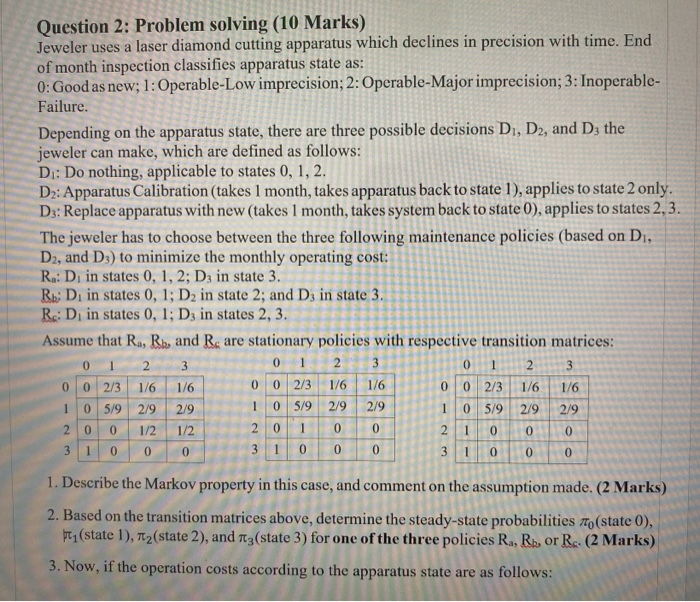Question 2: Problem solving (10 Marks) Jeweler uses a laser diamond cutting apparatus which declines in precision with time. End of month inspection classifies apparatus state as: 0: Good as new; 1: Operable-Low imprecision; 2: Operable-Major imprecision; 3: Inoperable- Failure. Depending on the apparatus state, there are three possible decisions D1, D2, and D; the jeweler can make, which are defined as follows: Di: Do nothing, applicable to states 0, 1, 2. D2: Apparatus Calibration (takes 1 month, takes apparatus back to state 1), applies to state 2 only. D3: Replace apparatus with new (takes 1 month, takes system back to state 0), applies to states 2, 3. The jeweler has to choose between the three following maintenance policies (based on D, D2, and D) to minimize the monthly operating cost: Re: D, in states 0, 1, 2, D3 in state 3. Rb: Din states 0, 1; D2 in state 2; and D3 in state 3. R.: D, in states 0, 1; D3 in states 2, 3. Assume that Ra, Rb, and R. are stationary policies with respective transition matrices: 0 1 0 2/3 1/6 1/6 0 2/3 1/6 1/6 0 2/3 1/6 1/6 0 5/9 2/9 2/9 0 5/9 2/9 0 5/9 2/9 2/9 0 3 1 0 3 0 2 3 2 3 0 2 3 0 0 0 1 2/9 1 2 0 1/2 1/2 2 0 1 0 0 2. 1 0 0 0 0 0 0 0 0 3 0 0 0 1. Describe the Markov property in this case, and comment on the assumption made. (2 Marks) 2. Based on the transition matrices above, determine the steady-state probabilities to (state 0), (state 1), 12(state 2), and Atz(state 3) for one of the three policies Ra, Rb, or R. (2 Marks) 3. Now, if the operation costs according to the apparatus state are as follows: Question 2: Problem solving (10 Marks) Jeweler uses a laser diamond cutting apparatus which declines in precision with time. End of month inspection classifies apparatus state as: 0: Good as new; 1: Operable-Low imprecision; 2: Operable-Major imprecision; 3: Inoperable- Failure. Depending on the apparatus state, there are three possible decisions D1, D2, and D; the jeweler can make, which are defined as follows: Di: Do nothing, applicable to states 0, 1, 2. D2: Apparatus Calibration (takes 1 month, takes apparatus back to state 1), applies to state 2 only. D3: Replace apparatus with new (takes 1 month, takes system back to state 0), applies to states 2, 3. The jeweler has to choose between the three following maintenance policies (based on D, D2, and D) to minimize the monthly operating cost: Re: D, in states 0, 1, 2, D3 in state 3. Rb: Din states 0, 1; D2 in state 2; and D3 in state 3. R.: D, in states 0, 1; D3 in states 2, 3. Assume that Ra, Rb, and R. are stationary policies with respective transition matrices: 0 1 0 2/3 1/6 1/6 0 2/3 1/6 1/6 0 2/3 1/6 1/6 0 5/9 2/9 2/9 0 5/9 2/9 0 5/9 2/9 2/9 0 3 1 0 3 0 2 3 2 3 0 2 3 0 0 0 1 2/9 1 2 0 1/2 1/2 2 0 1 0 0 2. 1 0 0 0 0 0 0 0 0 3 0 0 0 1. Describe the Markov property in this case, and comment on the assumption made. (2 Marks) 2. Based on the transition matrices above, determine the steady-state probabilities to (state 0), (state 1), 12(state 2), and Atz(state 3) for one of the three policies Ra, Rb, or R. (2 Marks) 3. Now, if the operation costs according to the apparatus state are as follows







